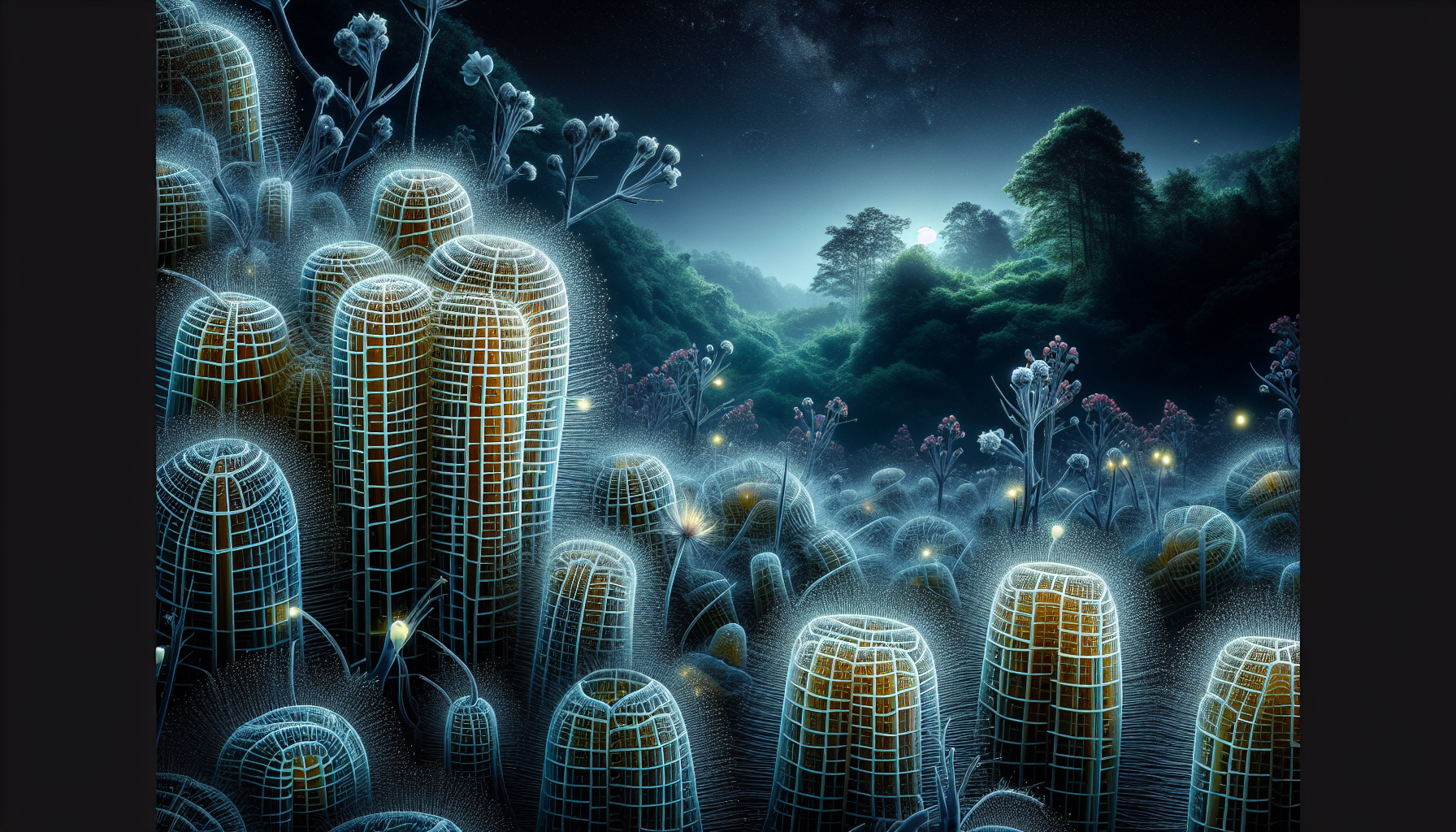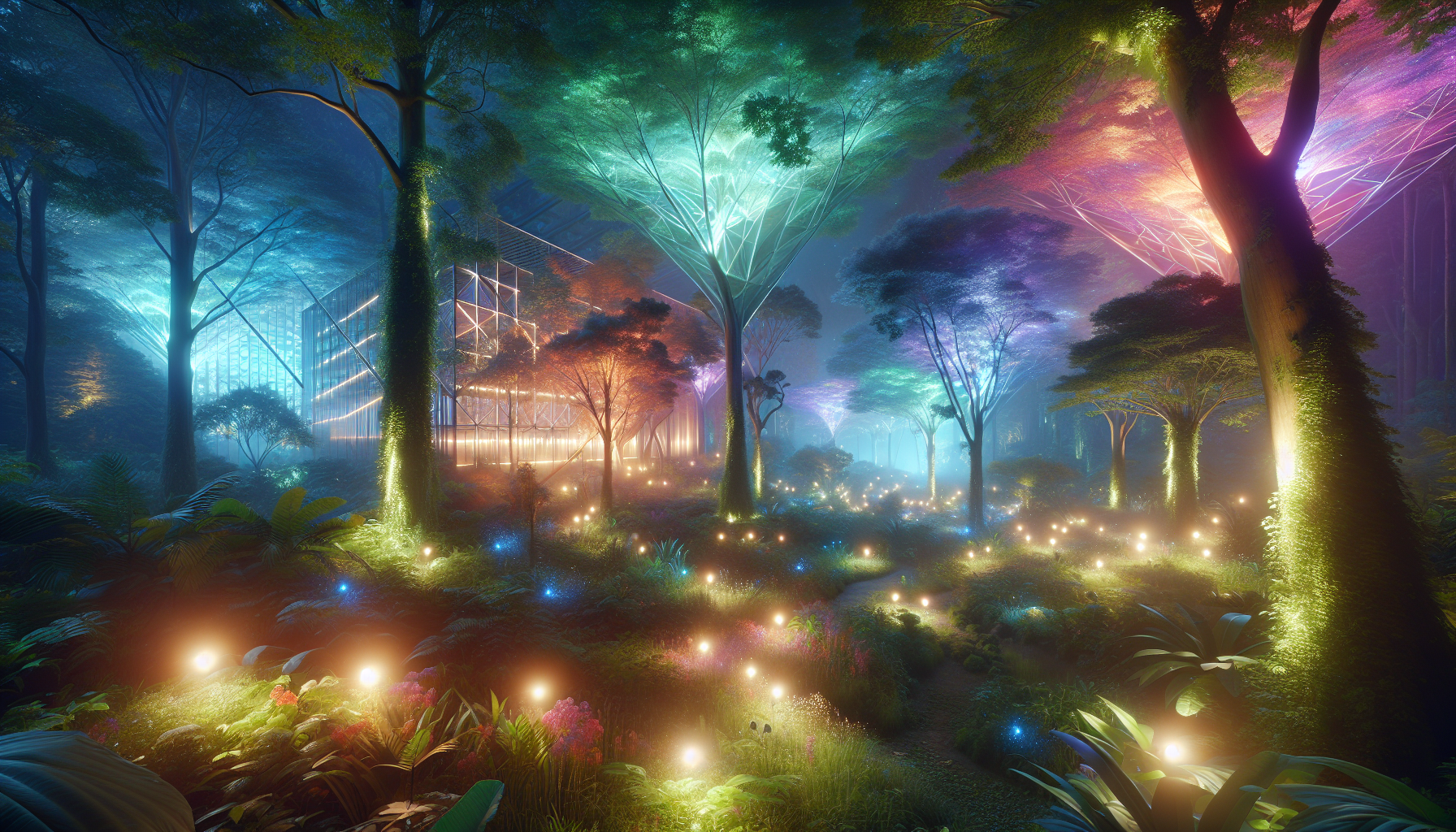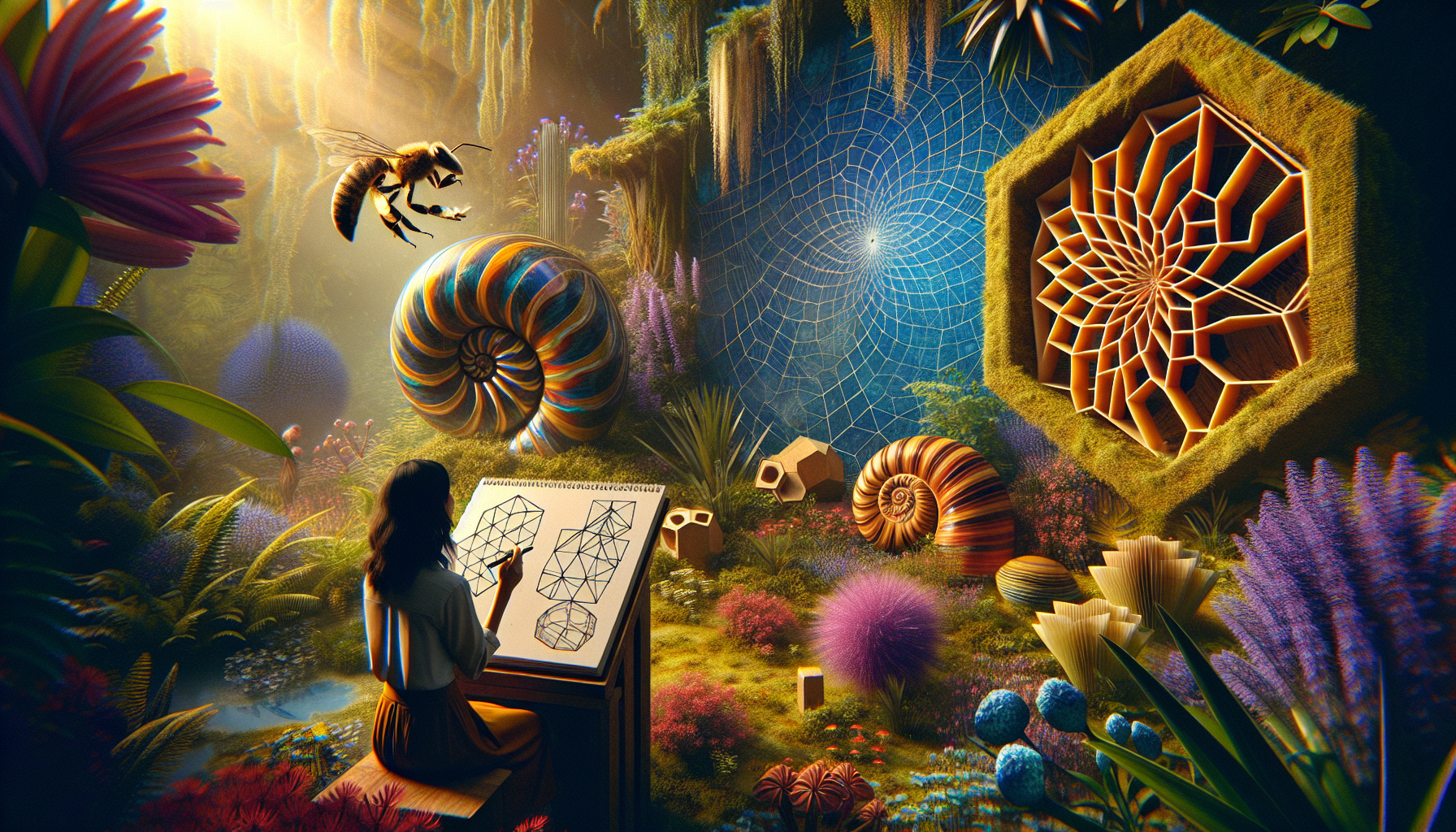In the vast tapestry of the natural world, few phenomena capture the imagination quite like the ethereal glow of fireflies on a warm summer night. These bioluminescent insects, often the subject of childhood wonder and adult curiosity, hold secrets that extend far beyond their twinkling allure. At the heart of their luminous dance lies an astonishing feat of natural engineering—an architecture so intricate and precise that it continues to baffle and inspire scientists across the globe. But what exactly is it about these delicate creatures that not only captivates our hearts but also serves as a beacon to a diverse array of other insects? 🌟
Welcome to the mesmerizing realm of firefly architecture, a world where microstructures perform a symphony of functions that extend beyond mere illumination. This article will journey through the complex interplay of biology, chemistry, and physics that underpins the glow of these fascinating insects. By delving into the microscopic details of firefly anatomy, we reveal how these creatures have perfected the art of attraction and communication over millennia. From the precise arrangement of light-emitting cells to the reflective surfaces that amplify their glow, fireflies are masterpieces of evolutionary design.
Our exploration will begin with the fundamentals of firefly biology, offering insight into the life cycle and ecological significance of these luminescent beings. We will unravel the bioluminescent process, a chemical reaction that, while seemingly simple, results in one of nature’s most beautiful spectacles. The dance of light is not just a wonder to behold but also a complex language spoken by fireflies to attract mates, deter predators, and even communicate with other species. As we peel back the layers of this natural wonder, you’ll discover the crucial role these insects play in their ecosystems and why preserving their habitats is essential for biodiversity.
But the intrigue does not stop there. The article will delve into the science of attraction, exploring how fireflies use their unique glow to lure specific insects. This selective attraction is not random but a sophisticated strategy honed by evolution. We’ll examine the microstructural nuances that enable fireflies to target particular insect species, providing them with evolutionary advantages in terms of reproduction and survival. The subtle interplay of light, color, and pattern creates a captivating spectacle that not only serves ecological purposes but also inspires technological innovations in fields such as bioengineering and optical technology.
Finally, we’ll take a glimpse into the future, where the study of firefly architecture is leading to groundbreaking applications in human technology. Scientists and engineers are borrowing from these natural designs to create more efficient lighting systems, improve communication technologies, and even develop medical diagnostics tools. By understanding the secrets of firefly microstructures, we are unlocking new possibilities that extend far beyond the boundaries of nature, proving once again that the tiniest of creatures can inspire the grandest of ideas.
Join us on this illuminating journey into the world of firefly architecture—a dance of light and life that continues to enchant, inform, and inspire. From the shimmering fields of the countryside to the cutting-edge laboratories of today, fireflies hold the key to a myriad of secrets waiting to be uncovered. As we embark on this exploration, prepare to be dazzled by the magic of these natural luminaries and the profound lessons they offer. 🌌
The Fascinating Architecture of Fireflies
Fireflies, often seen as enchanting night-time spectacles, possess a remarkable architectural anatomy that goes beyond mere beauty. These bioluminescent beetles are equipped with unique microstructures that play crucial roles in their survival and interaction with the environment. This intricate architecture is essential not only for their luminescence but also for attracting specific insects, a fascinating aspect of their existence that captivates scientists and nature enthusiasts alike. This article explores the detailed structure of fireflies and how these microarchitectures contribute to their ecological functions.
The bioluminescence of fireflies is one of nature’s most mesmerizing phenomena, attracting not just human admiration but also playing a critical role in the ecosystem. This light production is primarily used for communication, especially in mating rituals where different species of fireflies have specific light patterns to attract their mates. The firefly’s abdomen houses specialized cells and structures that enable this process, comprising luciferin, an enzyme called luciferase, oxygen, and ATP (adenosine triphosphate). When these components interact, they produce light without heat, a process known as cold light, which is incredibly energy-efficient.
Furthermore, the surface of a firefly’s lantern is covered with microstructures that enhance light emission. These structures, which include microscopic layers and ridges, help to refract and amplify the light, making it visible over longer distances and under various environmental conditions. This ability is not just for show; it plays a vital role in the firefly’s survival and reproductive success. The microstructures ensure that the light signals are both efficient and effective, reducing energy consumption and maximizing visibility.
Comparative Analysis: Firefly Microstructures vs. Other Insects
While fireflies are renowned for their bioluminescent abilities, they share certain architectural similarities with other insects, albeit with distinct differences that serve unique purposes. For instance, many insects have evolved microstructures on their exoskeletons that aid in communication, protection, or camouflage. However, the microstructures in fireflies are uniquely adapted for light production and signaling, setting them apart in the insect world.
In contrast, other insects like butterflies or beetles may have microstructures primarily for coloration or thermoregulation. Butterflies, for example, possess scales on their wings that reflect light to create vibrant colors, which are used for attracting mates or deterring predators. Meanwhile, beetles may have hardened elytra that provide protection and aid in temperature regulation. The key difference lies in the purpose and functionality of these microstructures, highlighting the diverse evolutionary paths insects have taken to adapt to their environments.
InsectMicrostructure FunctionAdaptationFireflyLight ProductionCommunication and MatingButterflyColorationMating and Predator EvasionBeetleProtectionSurvival and Temperature Regulation
Understanding these differences enhances our appreciation of the evolutionary ingenuity present in the insect world. For those curious about the broader context of insect microstructures, watching detailed documentaries on platforms like YouTube can provide enriching visual insights. Check out this video for more: “Bioluminescence: Nature’s Glow” from the SciShow channel.
How Fireflies Attract Specific Insects
Beyond their luminescent allure, fireflies also play a significant role in their ecosystems by attracting specific insects. This attraction is not merely a byproduct of their light production but a deliberate ecological strategy. The unique wavelengths of light emitted by fireflies are finely tuned to attract certain insects, serving multiple ecological functions, from pollination to predation. This aspect of firefly behavior underscores the complexity of their interactions within their habitats.
The emission of specific light patterns and wavelengths is integral to the firefly’s ability to attract insects. These light signals vary between species and are often species-specific, allowing fireflies to communicate effectively with potential mates while deterring unwanted attention from predators. Interestingly, some species of fireflies are known to mimic the light patterns of other species to attract prey, a strategy that showcases the cunning and adaptive behaviors of these insects.
Moreover, the chemical compounds associated with firefly bioluminescence, such as lucibufagins, have been found to have deterrent properties against certain predators. This dual function of firefly light – as both an attractant and a deterrent – highlights the sophisticated ecological adaptations these insects have developed over millions of years. For a closer look at how these interactions occur in the wild, consider exploring educational resources that delve into the ecological roles of fireflies.
The Role of Microstructures in Ecological Interactions
The microstructures of fireflies are not only pivotal for light production but also play a critical role in their ecological interactions. These structures enhance the effectiveness of their signaling, making them highly efficient at communicating over long distances. This efficiency is crucial for their survival, particularly in densely populated habitats where competition for resources is fierce.
Fireflies use their microstructures to optimize light transmission and reduce energy loss, ensuring their signals are bright and clear. This optimization is vital in attracting the right kind of attention – from potential mates to pollinating insects that help maintain the ecological balance. Additionally, the structural design of firefly lanterns has inspired biomimetic innovations in technology, particularly in the development of energy-efficient lighting solutions.
For those interested in the intersection of biology and technology, fireflies offer a fascinating case study of how nature’s designs can inspire human innovation. Explore more about this in resources that bridge the gap between natural sciences and technological advancements.
- Understand the unique role of fireflies in ecosystems.
- Explore how microstructures enhance ecological interactions.
- Discover biomimetic applications inspired by firefly architecture.
The wonder of fireflies extends far beyond their aesthetic appeal. By delving into their intricate architectures and ecological roles, we gain a deeper understanding of the complex and interconnected web of life. Their ability to lure specific insects through specialized microstructures is a testament to the sophistication of natural selection and evolution.

Conclusion
Conclusion: Illuminating the Artistry of Firefly Architecture
In delving into the mesmerizing world of firefly architecture, we have journeyed through a fascinating interplay of biology, physics, and ecology. The intricacies of firefly microstructures not only captivate our imaginations but also serve as a testament to the wonders of natural design. Throughout this exploration, several key themes have emerged that underscore the significance of understanding these luminous creatures and their habitats.
At the heart of our discussion lies the unique structural composition of firefly lanterns. These bioluminescent organisms have evolved sophisticated microstructures that optimize light emission, allowing them to communicate, attract mates, and deter predators. The structural efficiency of these lanterns is a marvel of nature, providing valuable insights into bio-inspired design and engineering. Researchers have found that the jagged scales and complex surfaces of firefly lanterns enhance their glow, a discovery that has inspired innovations in LED technology and optical devices source.
Furthermore, the ecological implications of firefly architecture are profound. These creatures play a critical role in their ecosystems, serving as both predator and prey, and their luminescent signals contribute to the balance of their natural habitats. The delicate relationship between fireflies and their environment highlights the importance of conservation efforts. Habitat destruction and light pollution pose significant threats to firefly populations, making it imperative for us to advocate for their protection. Initiatives to reduce artificial light at night and preserve natural habitats can have a substantial impact on sustaining firefly diversity and abundance.
In exploring how firefly microstructures attract specific insects, we have also touched on the broader concept of biomimicry. The natural world offers countless examples of intricate designs that humans can emulate for technological advancement. By studying how fireflies communicate and attract mates, scientists can develop new methods for pest control, reducing the need for harmful chemicals and promoting sustainable agriculture. This intersection of biology and technology showcases the potential for innovative solutions to some of our most pressing challenges.
As we conclude our exploration of firefly architecture, it is essential to recognize the broader implications of this research. The study of fireflies is not merely an academic pursuit but a reflection of our deep-seated curiosity and desire to understand the world around us. By appreciating the beauty and complexity of these creatures, we foster a sense of wonder and responsibility towards the environment.
The journey into the intricate world of firefly architecture invites us to consider our role in the ecosystem. It challenges us to reflect on how human activities impact the natural world and inspires us to take action in preserving biodiversity. As we have seen, the lessons gleaned from fireflies extend beyond the scientific community, offering valuable insights into sustainability, innovation, and the delicate balance of nature.
Let us draw inspiration from the resilience and ingenuity of fireflies, allowing their light to guide us towards a future where humans and nature coexist harmoniously. 🌟 Embrace the wonder of firefly architecture, and let it illuminate the path to a brighter, more sustainable world.
For further reading on the ecological and technological implications of firefly research, consider exploring these resources:
1. National Geographic – The Secret World of Fireflies
2. Smithsonian Magazine – How Fireflies Glow and What Signals They Send
Thank you for joining this exploration into the enchanting world of fireflies. Your engagement and curiosity are the first steps in making a positive impact. Let’s continue to shine a light on the wonders of nature and inspire others to do the same. ✨
Toni Santos is a visionary artisan and conceptual designer who channels the beauty of living organisms into structural expression. At Zureste, Toni explores the intricate elegance of insect anatomy, organic flow, and bioinspired design to create art that feels both natural and otherworldly.
Each creation Toni brings to life reflects a harmonic tension between structure and softness, wildness and control — echoing the complex intelligence found in the natural world. From beetle-like silhouettes to root-shaped contours, his work blurs the lines between biology, sculpture, and modern art.
Guided by fascination for metamorphosis, evolution, and pattern in nature, Toni’s pieces embody transformation. His BioLight Collection and conceptual series like Insect Type and Structure Aesthetics offer viewers more than aesthetic value — they present immersive experiences of living design.
As the creative force behind Zureste, Toni invites us to rethink beauty, architecture, and identity through a new lens — one shaped by wings, bones, spirals, and the microscopic poetry of the organic.
🌿 His creations reflect:
-
Design deeply rooted in the geometry of life
-
Inspiration from insects, roots, and the unseen natural order
-
A blend of science, spirituality, and visual storytelling
Whether you’re a lover of strange beauty, an admirer of evolution’s artistry, or a creative mind seeking something different, Toni welcomes you into a world where living forms become meaning, and surreal becomes sublime.





